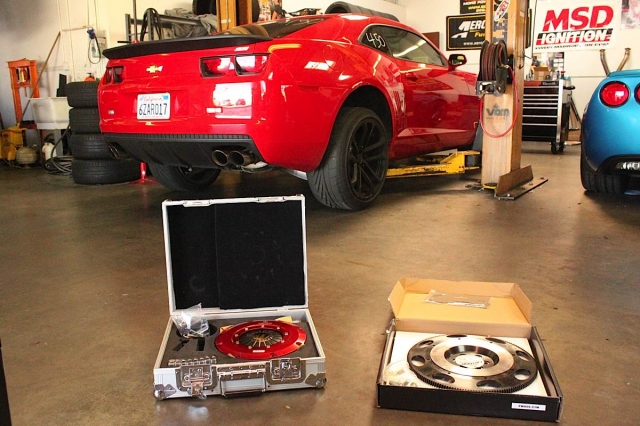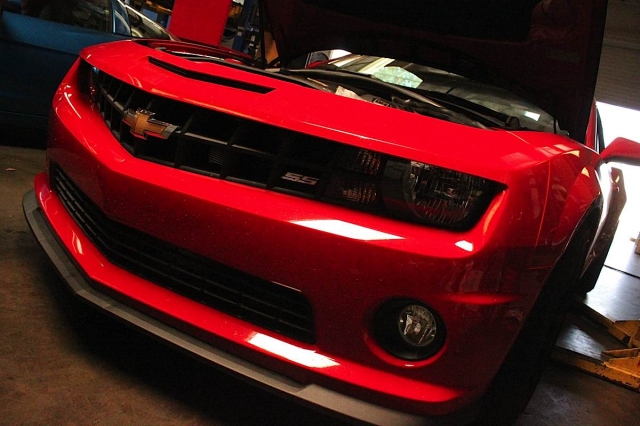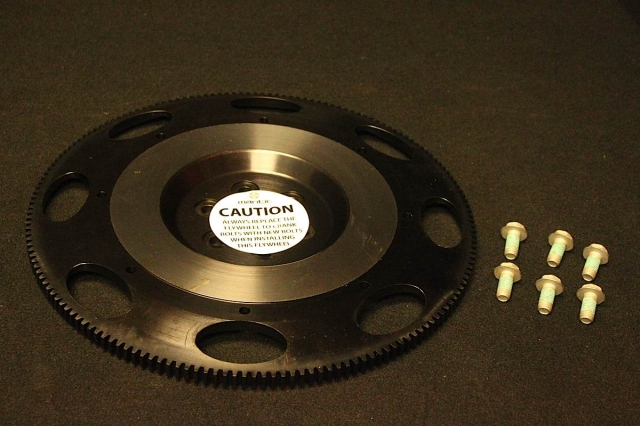The 5th Gen Camaro 1LE was purposely designed by Chevrolet to be a track car for the road racing enthusiast straight from the factory. But like any other genre of racing, the typical road racer is not going to be satisfied with a bone-stock Camaro to compete against some of the quickest cars around a race circuit – no matter how well prepared a factory 1LE car may be.
That’s why the aftermarket continues to step it up with suspension upgrades, performance bolt-ons, and other modifications to keep the track-ready 5th-Gen ahead of its competitors. Even clutch companies have something to offer 1LE Camaro owners, and Mantic Clutch is no different.
We’re not saying that the OEM clutch unit is a bad design, but it could benefit from an upgrade – especially when a car regularly sees track duty like our guinea pig featured in this story. So if you’re a 5th-Gen Camaro owner looking into an aftermarket clutch for your project car, read on…
Our Tester: 2013 Camaro 1LE
If you’ve been paying attention, we’ve been modifying Ryne Cunningham’s (of Cunningham Motorsports) 2013 Camaro 1LE. It’s seen several upgrades already, like a high-lift camshaft, long-tube headers, an AIRAID cold-air intake, and of course, a CMS custom tune. Unfortunately, the clutch went out the last time Cunningham was at the track, so the timing for this install was perfect.
Those familiar with Ryne Cunningham know that he races everything that he builds. So if there was going to be a clutch that could handle all of the power and abuse that this 2013 Camaro was going to see, it had better be a good one!
With all of the aforementioned modifications performed to the CMS 1LE, the Camaro is putting down a healthy 466 horsepower to the rear tires – enough to hold its own on the street or the track. But knowing Cunningham, he still has a few mods coming down the pipeline. So we took the opportunity to not only replace the ruined clutch in Cunningham’s Camaro, but to help him build a solid foundation upon which to build for the future.
Picking the Right Clutch
These suit high performance engines and enthusiastic driving styles, like that of the CMS Camaro, while allowing excellent drivability when needed. -Chris Astbury
We’ve heard nothing but good things about Australia-based Mantic up to this point, but never had a chance to try their hardware personally. Chris Astbury, Mantic Clutch’s tech expert, provided a bit of insight to us, even though they are 17 hours ahead of our Southern California office’s time zone which made arranging a phone call a bit of an adventure.
Mantic manufactures a wide range of different clutches for different types of applications, and the 9000 HD Cerametallic we’re installing is specially designed for applications with substantial increases in horsepower and torque above stock, but with a requirement for street-friendly capabilities and the endurance that’s necessary for a road racing application.
The 9000 HD is a twin-disc, 9-inch diameter modular clutch that can handle four-digit torque figures and meets SFI certification standards for track use. As we know, the amount of mass a clutch incorporates affects both the amount of power it takes for the engine to accelerate it as well as drivability aspects, and Mantic offers two levels of 9000-series low mass clutches, the Plus and Track, to allow you to optimize your vehicle performance to your personal driving style.
The 9000 HD is aptly named, as every component of this clutch package is built to handle up to 1,010 pound-feet of torque and all of the abuse the hardcore road racer can throw at it. In addition to having two friction discs, an intermediate 'floater' steel disc that engages rectangular stands on the pressure plate assembly distinguishes this from a conventional single-disc clutch.
The twin disc aspect of this clutch design is important because it allows four-digit torque capacity without being a brutal ordeal for your left leg. Clutch holding power is determined by four different factors:
- Swept area – the amount of friction material and pressure plate that come in contact with each other
- Leverage – the physical size of the clutch, and how far out from the center force is applied
- Friction material – how “grippy” the material the clutch disc’s pads are made from is
- Clamping force – how much pressure the spring applies to hold the clutch together when the pedal is released
Traditional single disc race clutches got their increased torque capacity mostly through very aggressive friction materials and high clamp loads, making them very unfriendly for anything less hardcore than track-only use. Plenty of hot rodders learned an expensive lesson when they asked for the highest-capacity clutch a company could make, only to find out that it was grabby and exhausting to use even occasionally on the street.
Twin disc designs take advantage of the first factor – almost double the contact area of a single disc – to offer better holding power without sacrificing drivability. Clamp loads can be kept close to stock, for a clutch pedal that feels close to OEM, and less-aggressive friction materials can be used to make for smoother engagement. Because the overall area at work is so much larger, the clutch can actually be smaller in diameter (and therefore have a lower moment of inertia despite having a lot more components) than the stock clutch.
As Astbury tells us, “The 9000 Series is a low MOI (Moment of Inertia) twin disc clutch that offers a high level of performance and also allows you to select options that best suit you. The key to this unit is the Sprung Street Cerametallic discs. These suit high performance engines and enthusiastic driving styles, like that of the CMS Camaro, while allowing excellent drivability when needed.”
Per Astbury, “The pedal effort for a Mantic twin disc with the standard diaphragm is almost identical to the OEM. A GTO / G8 OEM clutch requires approx 10 pounds of effort at the pedal, and a Mantic is 11 pounds. Even with the HD diaphragm it is only 14 pounds. As a clutch pedal gets progressively heavier as the clutch wears, the new Mantic may actually feel lighter than the old unit.”
Getting Sprung
Mantic’s 9000 series clutches can be had with either a “sprung” or “rigid” hub, and with organic or ceramic friction materials, allowing the engagement characteristics, strength, and holding capacity to be tailored for a particular application. In our case, the street-friendly sprung hub design, while not offering the ultimate simplicity and durability of a rigid race-style hub, will still have plenty of reserve strength to handle the torque supplied by our LS3 while making the car more pleasant to drive and protecting other driveline components from shock loads. According to Mantic, stepping up to the Cerametallic friction material gives better torque capacity and heat tolerance than an OEM-style organic facing, with what they claim is almost no tradeoff in terms of adverse drivability.
“Cerametallic is a term we use for a “ceramic style” friction material,” Astbury explains. “It comes in various forms, either by being bonded onto a steel backing ring, or by being riveted to the main plate of the disc. These riveted buttons are often called ‘puck’ style clutches. The bonded types are easily the most popular type, because they allow a Marcel spring to go between the two facings. This allows the facings to compress as the clutch is engaged, and allows for smoother engagement on take off. The advantage over organic materials is the higher coefficient of friction, which in turn translates to increased torque drive capability.”
Beyond the increase in capacity, the Mantic twin also helps reduce the amount of power the engine has to invest in spinning the flywheel and clutch assembly. “The OEM clutch and flywheel is around 50 pounds,” says Astbury. “A Mantic twin disc is between 32 – 34 pounds. The lighter weight is also closer to the crankshaft centre line, also reducing the MOI.”
You might wonder if that light weight comes at the expense of strength, but Astbury assures us it’s quite the opposite. “Mantic twins are made of billet steel and aluminum, which allows a torsional strength much better than a pressed steel cover. If there is cover distortion, there can be release problems. The use of locked in billet steel drive blocks rather than alloy material also adds strength. Although the Mantic clutch is much lighter than OEM, they are designed and engineered to provide the maximum strength possible.”

Yes, Mantic clutches arrive to your door in a metal “road case” like the kind used to ship concert sound equipment, and the one we were going to be installing into CMS’s 1LE was no exception.
Installation
Installing the Mantic 9000 HD Cerametallic is just like installing any other aftermarket clutch, once you get past the “road case” that Mantic uses to ship every clutch. It helps protect the kit when being shipped, since Mantic is based out of Australia. Just like a conventional single-disc clutch, a splined alignment tool (provided with the kit) is used to hold the discs in position while the clutch cover is being bolted to the flywheel, and the throwout bearing arrangement is the same as stock.
Installing the new clutch requires pulling the old one, obviously, and as anyone who has replaced a clutch in a fifth-gen Camaro knows, that meant removing the transmission, driveshaft, and the mid-section of the car's exhaust system.
Since the Camaro couldn’t move under its own power, the first order of business was to push the 1LE back into the shop and get it onto the lift. Once up in the air, the CMS crew immediately set to work on unplugging the oxygen and transmission sensors, removing the driveshaft, sections of the exhaust, the transmission, and of course, the ruined OEM clutch.
Working on the Camaro was “Tex,” CMS’s resident technician who knows his way around basically every LS-powered GM vehicle out there, and the 2013 Camaro is no exception. He made the clutch swap complete in quick order, and we were in and out of the CMS shop in less than three hours.
With the new flywheel installed we followed up by installing the clutch pack and cover, first tightening them down, then torquing them down to spec.
While the transmission was out, Tex replaced the broken slave cylinder in the gearbox with a brand new OEM unit. Once that was handled, it was time to button everything up the way it was removed – in reverse order. There were no problems or unplanned issues when installing this clutch. We simply followed along with the instructions and installed it like any other clutch.
Testing the Results
With the Camaro buttoned back up and all four tires on the ground, we took the car around the block for a test spin. We weren’t sure exactly what to expect – besides pushing the pedal in a Mantic-equipped Holden on a trade show floor, this was our first experience with one of their clutches. A new clutch with four-digit torque capacity usually means stalling the car once or twice while trying to pull away from a stop, at least until you get used to it, and the friction material and steel get to know each other a bit.
We were pleased to discover that the Mantic 9000 started out as a very driver-friendly clutch, and got even better as it completed the recommended break-in period. It’s not as soft as the OEM clutch, but that’s because this unit was designed for serious competition, not the guy looking to simply bolt aftermarket parts for his car and go cruising. If you want a clutch assembly biased more directly towards the street, then the Mantic 3000 Series dual-disc is for you.
Now that the clutch is fully broken in, and we’ve had a chance to get some street miles under our belt, we have to say that the Mantic clutch exceeded our expectations. It’s smooth and quiet enough that anyone jumping into the car for the first time would be hard-pressed to tell it was a very-high-capacity dual disc clutch, and it’s already proven the ability to hold the current power level of our 1LE test car. Of course, Cunningham has a long history of pushing cars to the limit, so we’ll be keeping an eye on things as this Camaro evolves and grows to take full advantage of the massive torque capacity of the new clutch.

After we installed the clutch, we bled the system to ensure there weren’t any air bubbles that could negatively effect the way the Mantic performs. The end result was a clutch setup that can handle four-digit torque without working you like half a stair machine at the gym while you’re driving in traffic.

































